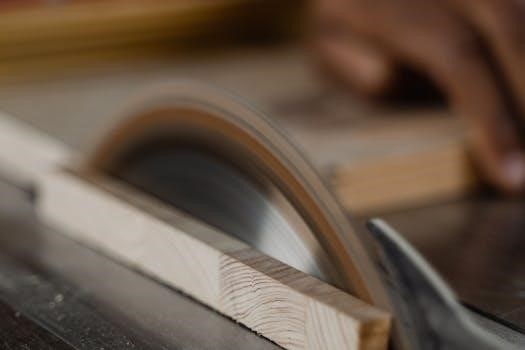
Milwaukee Circular Saw Guide Rail⁚ An Overview
Milwaukee circular saw guide rails offer woodworkers and construction professionals enhanced precision. These rails, compatible with Milwaukee’s circular saws, ensure straight, clean cuts in sheet goods and lumber, improving accuracy and efficiency.

Understanding Guide Rails
Guide rails are essential tools for achieving precise cuts with circular saws. They provide a stable, straight edge for the saw to follow, resulting in cleaner, more accurate cuts than freehand methods.
What is a Guide Rail?
A guide rail is a long, straight track designed to guide a circular saw precisely. It allows users to make accurate, repeatable cuts in various materials, especially sheet goods like plywood. The saw’s base rides along the rail, ensuring straight cuts. Guide rails often feature anti-slip strips for stability. They are typically made from aluminum or other durable materials. A guide rail minimizes splintering and tear-out, providing a clean edge. Using a guide rail improves safety. It can be a standalone accessory. It is an alternative to dedicated track saws.

Milwaukee Guide Rail Compatibility
Milwaukee offers guide rails designed to work seamlessly with their track saws. Compatibility extends to some circular saws with adapters. This ensures precise, clean cuts across various materials with the appropriate tools.
Milwaukee Track Saw and Guide Rail Systems
Milwaukee track saw and guide rail systems provide a comprehensive solution for precise cutting. These systems integrate a plunge-cutting track saw with a specialized guide rail. The saw glides along the rail, ensuring straight, splinter-free cuts in sheet goods like plywood and melamine. The anti-tip feature is designed so that the Wen track/guide rail works perfectly with the M18 track saw. This combination is designed for efficiency and accuracy in professional woodworking applications.

Circular Saw vs. Track Saw
Circular saws are versatile for various cuts, while track saws excel in precision, using a guide rail for straight, clean cuts. Track saws are essentially circular saws.
Key Differences Between Circular Saws and Track Saws
The primary distinction lies in precision and guidance. Track saws run along a guide rail, ensuring straight, splinter-free cuts, especially on sheet goods. Circular saws are more versatile but require additional tools for accurate cuts. Track saws often feature zero-clearance bases to minimize tear-out. Circular saws are cheaper. A track saw blade sits above the base when not in use. Circular saws include protective guards. Ripping thin strips and cross-cutting timber sections are better with circular saws.
Precision and Accuracy
Milwaukee guide rails significantly enhance the precision and accuracy of circular saw cuts. Unlike freehand cutting, a guide rail system ensures straight, consistent lines, especially crucial for large sheet materials. The tight fit between the saw and rail minimizes wandering, resulting in cleaner edges and less waste. This controlled cutting action is vital for achieving professional-quality results in woodworking and construction projects, allowing for repeatable accuracy that is difficult to achieve with a standard circular saw alone.
Advantages of Using a Guide Rail with a Circular Saw
Using a guide rail with a Milwaukee circular saw enhances cut quality by reducing tear-out. Guide rails also provide enhanced safety, ensuring straight, accurate cuts that improve overall efficiency.
Improved Cut Quality
Milwaukee guide rails significantly enhance cut quality when used with circular saws. The guide rail ensures the saw travels in a perfectly straight line, eliminating the potential for wandering that can occur with freehand cuts. This results in cleaner, more precise edges, minimizing tear-out, especially in delicate materials like plywood veneers. The tight fit between the saw and rail further contributes to smooth, finished cuts, reducing the need for additional sanding or edge finishing. Improved cut quality is very important.
Enhanced Safety
Using a Milwaukee guide rail with a circular saw enhances safety by providing increased control and stability during cuts. The guide rail system allows the user to focus on guiding the saw along a fixed path, reducing the risk of slips or sudden movements that could lead to injury. The controlled cutting action minimizes the chance of kickback, a common hazard with circular saws. The user’s hands are kept further away from the blade, adding an extra layer of protection. Safer cuts are achieved when the rail is in use.

Alternatives to Dedicated Track Saws
While track saws offer precision, alternatives exist. These include using a straight edge with clamps or lever-activated clamps as guides for circular saws, providing cost-effective solutions for achieving straight cuts.
Using a Straight Edge as a Guide
A common alternative to dedicated track saws involves using a straight edge, like a metal rail or even a carefully chosen piece of lumber, as a guide for your circular saw. This method requires securing the straight edge firmly to the material being cut, ensuring it doesn’t move during the cutting process. Clamps are essential for this purpose. While this approach can work, it demands careful setup and may not provide the same level of precision as a track saw system, and has the potential to wander.
Lever-Activated Clamps
Lever-activated clamps offer another alternative for guiding circular saws. These clamps, often long and straight, secure to the workpiece and provide a straight edge for the saw to follow. They offer a quicker setup compared to traditional clamps and straight edges. However, they might not offer the same level of precision and stability as a dedicated track saw system. The quality of the cut depends heavily on the clamp’s straightness and the user’s technique. These are useful if you need a roughly accurate cut occasionally.
Considerations for Choosing a Guide Rail
Selecting the right guide rail involves evaluating material quality, length, and compatibility. Consider the durability needed for your projects and the required cutting length for various materials.
Material and Build Quality
The material and build quality of a guide rail significantly impact its durability and performance. High-quality aluminum extrusions offer a balance of lightweight maneuverability and robust strength, resisting bending or warping under pressure. A well-constructed guide rail ensures consistent, accurate cuts over its lifespan, enhancing safety and minimizing errors. Look for features like non-slip strips or coatings on the underside of the rail to prevent movement during cuts. Precise manufacturing tolerances are crucial for seamless saw gliding and reducing vibration, ultimately affecting cut quality and user experience. Investing in a durable guide rail extends tool life and minimizes project waste.
Length and Extension Options
Guide rail length dictates the maximum cut length achievable in a single pass. Shorter rails offer portability, while longer rails accommodate larger sheet goods. Extension options enhance versatility. Connecting multiple rails extends cut capacity for oversized projects. Secure and seamless connections are crucial, ensuring consistent alignment along the extended length. Consider storage space when selecting rail lengths. Evaluate typical project sizes to determine optimal rail length. Some manufacturers offer varying lengths to suit diverse needs. Extension connectors should maintain rigidity, preventing deviations during cuts. Proper length selection optimizes efficiency and reduces the need for repositioning.
Aftermarket Guide Rail Options
Aftermarket guide rail options offer alternatives to manufacturer-specific systems. These rails can provide cost savings or compatibility with various circular saw brands. Evaluate quality and features before purchasing.
Compatibility with Different Circular Saw Brands
When considering aftermarket guide rails, compatibility with your specific circular saw brand is crucial. Not all guide rails are universally compatible, so research and verify fitment before purchase. Some aftermarket options offer adapters or universal designs to accommodate various brands, like Makita or Wen. Checking reviews and specifications ensures proper alignment and functionality. Correct alignment is essential for achieving precise cuts and preventing safety hazards. Confirm compatibility to avoid frustration and ensure optimal performance from your circular saw and guide rail system.
Cost Comparison
Comparing costs involves assessing initial investment and long-term value. Track saws typically have a higher upfront cost. A circular saw with a guide rail system offers a more budget-friendly alternative.
Track Saw vs. Circular Saw with Guide Rail System
Many individuals find themselves puzzled by the distinctions between track saws and circular saws equipped with guide rails. Track saws are designed for precise, straight cuts using a guide rail. Circular saws offer versatility, suitable for various cutting tasks.
A circular saw with a guide rail can achieve accuracy similar to a track saw. The WEN track/guide rail works with the M18 track saw. This offers a cost-effective alternative to dedicated track saw systems for achieving precise cuts.
 brits guide to orlando 2024
brits guide to orlando 2024  bosch serie 4 tumble dryer manual
bosch serie 4 tumble dryer manual  aperture shutter speed iso chart pdf
aperture shutter speed iso chart pdf  district of columbia driver’s manual
district of columbia driver’s manual  us navy lays keel for constellation-class guided-missile frigate.
us navy lays keel for constellation-class guided-missile frigate.